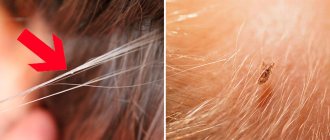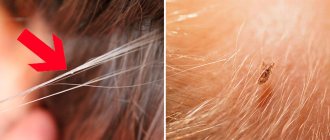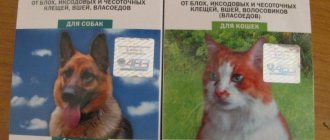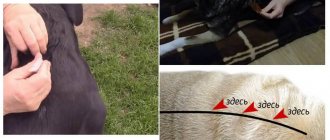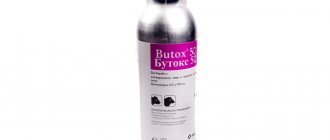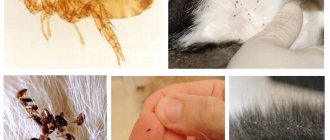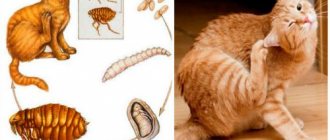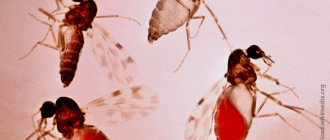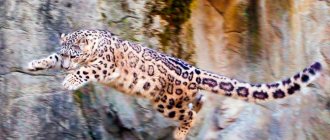Doses and method of administration
Animals are treated outdoors or in a well-ventilated room with open windows (vents), away from open fire, after removing cages with ornamental birds from the room and covering aquariums with fish. To prevent licking of the drug, the animal is put on a muzzle or the jaws are secured with a loop of braid. Before use, shake the bottle with the drug and, holding it vertically, press the spray head, directing the aerosol torch at the surface to be treated from a distance of 20 - 25 cm. To destroy insects and prevent attacks on animals by ixodid ticks, spray the entire body of the animal against hair growth, slightly moisturizing the fur (in animals with long-haired breeds, the fur is lifted with your hand). Covering the animal's eyes, treat the ears and chest, lightly rub the drug around the eyes and nose with your fingertips, then treat the neck, torso, limbs, belly and tail. 20 minutes after treatment, the animal’s fur is combed with a comb, after which the animal’s jaws are freed from the muzzle (braid). To destroy ixodid ticks on the body of an animal, the drug is applied to the tick and the place of its attachment to the skin (one press on the spray head). If within 20 - 30 minutes the tick does not fall off spontaneously, it is carefully pulled out with tweezers and destroyed. For preventive purposes, treatments are carried out according to indications, but no more than once a month against insects and no more than once every fourteen days against ixodid ticks (during the season of their parasitism). In order to prevent re-infestation by fleas, bedding, blankets and other animal care items are treated with a spray at the rate of 2 ml (four presses on the spray head) per 1 m2 of surface to be treated. For three days, the animal is not allowed to come into contact with the treated items, and before subsequent use, they are washed (washed) with detergent. When cats are affected by notoedrosis, and dogs are affected by sarcoptic mange, the drug is applied to the affected areas of the body, previously cleared of stools, covering the borderline healthy skin up to 1 cm. Treatment with the drug is carried out, slightly moisturizing the affected areas, 2 - 4 times with an interval of 7 - 10 days until the animal’s clinical recovery , which is confirmed by two negative results of acarological studies. Animals with large affected areas are treated in two doses with an interval of 1 day, applying the drug to the affected areas of first one and then the other half of the body. Until the fur is completely dry after treatment, animals should not be allowed to lick the preparation, nor should they be allowed near open fires or heating devices. In case of increased individual sensitivity of animals to the drug (lacrimation, excessive salivation, muscle tremors) or signs of skin irritation, the drug should be washed off with soap and water.
Features of application:
Processing should be carried out in a well-ventilated area or outdoors away from fire. Shake the spray bottle and, holding it vertically, press the spray head at a distance of 20–25 cm from the affected surface. Treat the entire body of the animal in the direction of hair growth. 20 minutes after the procedure, comb his fur. If cats are affected by notoedrosis, apply the drug to the affected areas of the body, cleared of scabs, including up to 1 cm of adjacent healthy skin. The procedure using the drug "Bars" must be carried out 2-4 times with an interval of 5-7 days until the animal is completely cured.
special instructions
Animals should be treated with the spray in a well-ventilated area. While working with the drug, smoking, drinking and eating are not allowed. When finished, wash your hands with warm water and soap. You should not pet the animal or allow it near small children for 24 hours after treatment with the drug. If the drug accidentally gets on the skin or mucous membranes, it should be washed off immediately with a stream of water. Empty bottles of the drug must not be used for household purposes; they are thrown into garbage containers.
Storage conditions
In a dry, dark place at a temperature between 0 °C and 30 °C. Shelf life: 2 years.
Manufacturer
Agrovetzaschita S.-P. NVC LLC, Russia
Address: 129329, Moscow, st. Kolskaya, 1, office 213. Production address: 141300, Moscow region, Sergiev Posad, st. Central, 1. Tel. (multichannel) Fax
Bars insectoacaricidal spray, for dogs, fl. 200 ml
COMPOSITION AND RELEASE FORM Solution for external use, transparent, colorless to light yellow, with a slight specific odor, contains fipronil as an active ingredient - 3.1 mg/ml, as well as glycerin, castor oil and other auxiliary components. The drug is produced packaged in 100 and 200 ml, in polyethylene bottles of appropriate capacity with mechanical spray heads, which are packaged in cardboard boxes along with instructions for use.
PHARMACOLOGICAL PROPERTIES Spray "Bars" is effective against fleas, lice, hair lice, ixodid and sarcoptic ticks that parasitize dogs and cats. The drug has a systemic and contact effect, causing the death of parasites immediately after their attack on the treated animal. The spray has a pleasant smell and has a repellent effect.
INDICATIONS For the treatment of dogs and cats with entomosis, notoedrosis, sarcoptic mange, damage to animals by ixodid ticks, as well as to prevent attacks of ectoparasites on animals.
DOSES AND METHOD OF APPLICATION Before use, shake the container and apply the drug to the animal from a distance of 20 cm, sequentially treating the ears, chest, neck, torso, legs, tail. Avoid getting the drug in your eyes, mouth and nose! When treating dogs and cats of long-haired breeds, the drug is applied in the direction “against the hair” to the skin and base of the hair. For therapeutic purposes, the drug is used once. For preventive purposes, cats are treated according to indications, but not more than once a month. In dogs, prophylaxis against ticks is carried out once every two weeks, against fleas - once a month. Bedding for animals is treated at the rate of 4 presses on the spray valve - per 1 m2 of surface. For 3 days, do not allow the animal to come into contact with treated items, and before use, wash them with detergent.
SIDE EFFECTS When using the drug according to the instructions, no side effects or complications are observed. Causes irritation upon contact with mucous membranes.
CONTRAINDICATIONS Contraindicated in sick and convalescent animals, lactating females, as well as puppies and kittens under 10 weeks of age.
SPECIAL INSTRUCTIONS Treatment is carried out outdoors or in well-ventilated areas. If the spray gets on the skin or mucous membranes of a person, the drug must be washed off with plenty of water.
STORAGE CONDITIONS The drug should be stored in the manufacturer's sealed packaging, separate from food and feed, in a dry place, protected from direct sunlight, out of reach of children, at a temperature of 0°C to 25°C. Shelf life, subject to storage conditions in closed packaging, is 12 months from the date of production. Do not use the drug after the expiration date.
Spray Bars insectoacaricidal for cats 100ml
DESCRIPTION
Insectoacaricidal spray Bars is used for cats, ferrets, chinchillas, guinea pigs, rats and hamsters for entomosis (lice, fleas, lice), sarcopticosis (sarcoptosis, notoedrosis), cheyletiellosis and ixodid ticks, as well as to prevent attacks of ectoparasites on animals.
COMPOUND
Fipronil - 0.3%, glycerin - 1%, hydrochloric acid - 5%, castor oil - 0.1%, distilled water - 15% and isopropyl alcohol - up to 100%.
PHARMACOLOGICAL PROPERTIES
Insectoacaricidal spray Bars belongs to medicinal insectoacaricidal preparations of the phenylpyrosol group.
Fipronil, which is part of the drug, has a pronounced insectoacaricidal activity against the preimaginal and imaginal phases of development of fleas, lice, lice, ticks (ixodid, sarcoptoid, cheyletiella), parasitizing dogs, cats, ferrets and rodents.
The mechanism of action of fipronil is to block GABA-dependent ectoparasite receptors, disrupting the transmission of nerve impulses, which leads to paralysis and death of insects and ticks. After spraying the animal, fipronil is gradually distributed over the entire surface of the body, practically without being absorbed, does not enter the systemic bloodstream, accumulates in the epidermis, hair follicles and sebaceous glands, has a long-term contact insectoacaricidal effect, providing protection to animals from repeated insect attacks for at least 1 month, from ixodid ticks - at least 2 weeks.
Bars spray, in terms of the degree of impact on the body, is classified as a “low-hazard” substance (hazard class 4 according to GOST 12.1.007-76), in recommended doses it does not have a resorptive-toxic, locally irritating or sensitizing effect; Causes irritation upon contact with eyes.
DOSAGE AND APPLICATION
Before use, shake the bottle with the drug and, holding it vertically, press the spray head, directing the aerosol torch at the animal’s fur from a distance of 25-30 cm. One press on the spray head when using a 200 ml bottle provides a dose of 0.5 ml, at using a 100 ml bottle - 0.25 ml of the drug.
To destroy insects and prevent attacks on animals by ixodid ticks, spray the entire body of the animal against hair growth, slightly moisturizing the fur (in animals of long-haired breeds, the hair is lifted by hand, applying the drug to the skin and base of the hair).
The dose of the drug for dogs, cats and ferrets, depending on the condition of the coat, is 0.5-1.0 ml per 1 kg of animal weight, which is achieved, respectively, by 1-2 clicks on the spray head of a 200 ml bottle and 2-4 clicks for a bottle volume 100 ml. Covering the animal's eyes, treat the ears and chest, lightly rub the drug around the eyes and nose with your fingertips, then treat the neck, torso, limbs, belly and tail. 20 minutes after treatment, rub the animal and comb it with a comb.
To destroy ixodid ticks on the body of an animal, the drug is applied to the tick and the place of its attachment to the skin (one press on the spray head). If the tick does not fall off spontaneously within 20-30 minutes, it is carefully pulled out with tweezers and destroyed. Repeated treatments are carried out according to indications, but against insects no more than once a month, against ixodid ticks no more than once every two weeks.
When cats are affected by notoedrosis, and dogs and ferrets are affected by sarcoptic mange, the drug is applied to the affected areas of the body, previously cleared of scabs, covering borderline healthy skin up to 1 cm, at the rate of 1 ml per 10 cm2 of the affected area of the animal's body. Treatment is carried out two to four times with an interval of 7-10 days until the animal’s clinical recovery, which is confirmed by two negative results of acarological studies. Animals with large affected areas are treated in two doses with an interval of 1 day, applying the drug to the affected areas of first one and then the other half of the body.
When decorative rodents are affected by ectoparasites, the drug is evenly applied to the fur at the rate of: hamsters - 0.25 ml/animal, chinchillas, guinea pigs and rats - 0.25 ml per 100 g of animal weight.
Until the fur is completely dry after treatment, animals should not be allowed to lick the drug, nor should they be allowed near open fires or heating devices.
SPECIAL INSTRUCTIONS
Insectoacaricidal spray Bars should not be used simultaneously with other insectoacaricidal agents.
The drug is not intended for use in productive animals.
CONTRAINDICATIONS
A contraindication for use is the increased individual sensitivity of the animal to the components of the drug.
Patients with infectious diseases, convalescent and weakened animals, pregnant and lactating females, kittens, dog and ferret puppies under 10 weeks of age and rodents under 2 weeks of age cannot be treated with Bars spray.
SIDE EFFECTS
As a rule, there are no side effects or complications when using Bars spray in accordance with these instructions.
If the animal's individual sensitivity to the components of the drug increases and complications occur (excessive salivation, lacrimation, vomiting), treatment is stopped and the drug is washed off with water and detergent.
SHELF LIFE AND STORAGE
Store the spray in the manufacturer's sealed packaging, separately from food and feed in a place protected from light and moisture, away from heating devices and open flames, at a temperature from 0°C to 30°C.
The shelf life of the drug, subject to storage conditions, is 2 years from the date of production.
PACKAGE
The drug is produced in polymer bottles with a mechanical spray head, packaged in 100 ml. Bottles with a capacity of 100 ml are placed individually in a cardboard box.
